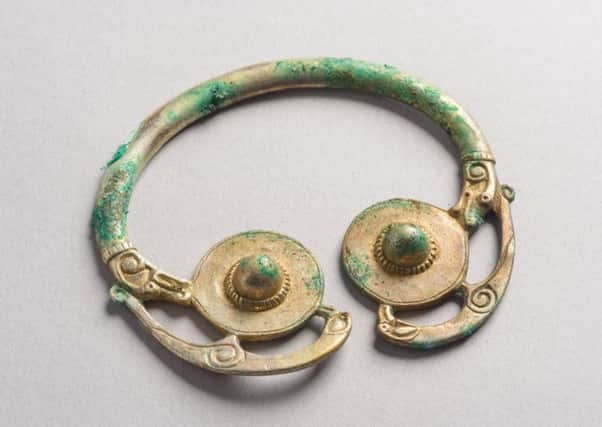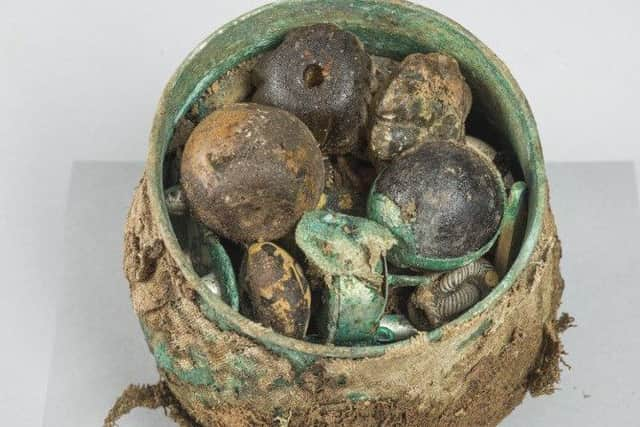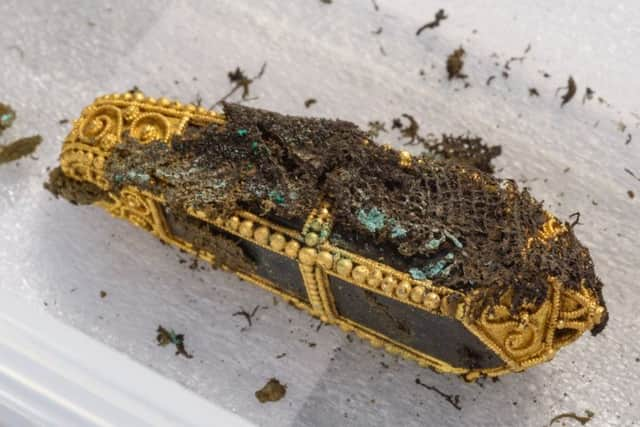Experts reveal contents of Viking treasures found in Galloway


The cache of treasures, which are believed to date from the 9th and 10th centuries, have been revealed for the first time since their discovery in a field in Galloway.
They are thought to have been accumulated across Europe over several generations before being buried inside the silver alloy Carolingian vessel.
Advertisement
Hide AdAdvertisement
Hide AdInside the pot – which still had its lid intact – were six silver Anglo-Saxon brooches dating back to the 9th century and one of the biggest hoards of its kind to be discovered in the UK.


It also included a silver brooch from Ireland, Byzantium silk from Turkey, beads, a gold ingot and several mysterious gold and crystal objects wrapped in cloth.
The hoard has been revealed for the first time since retired businessman Derek McClennan found a huge haul of Viking treasure on Church of Scotland land, which has never been identified, in September 2014. More than 100 silver and gold items were excavated from the site, including jewellery, armbands, brooches and a solid silver cross.
A painstaking conservation project has since been led by experts at Historic Environment Scotland and Scotland’s official “treasure trove” unit, which ensures that significant finds are made available to museums and galleries.
The fragile pot was eventually opened up after undergoing an X-ray scan at Borders General Hospital.


Mr McLennan is in line for a significant six-figure reward after embarking on a treasure hunt with two retired Church of Scotland ministers.
He said at the time: “I dragged myself out of my sickbed because I had two friends who wanted to detect and I’m a bit of an obsessive.
Advertisement
Hide AdAdvertisement
Hide Ad“I unearthed the first piece; initially I didn’t understand what I had found because I thought it was a silver spoon and then I turned it over and wiped my thumb across it and I saw the saltire-type of design and knew instantly it was Viking. Then my senses exploded.”
Richard Welander, head of collections at Historic Environment Scotland, said the opening of the Viking pot was the equivalent to the discovery of Tutankhamun’s tomb in 1922.


He said: “Before removing the objects we took the rather unusual measure of having the pot CT-scanned, in order that we could get a rough idea of what was in there and best plan the delicate extraction process.
“That exercise offered us a tantalising glimpse but didn’t prepare me for what was to come. These stunning objects provide us with an unparalleled insight into what was going on in the minds of the Vikings in Galloway all those years ago.”
Under Scots law, all objects that are found where the owner is either unknown or cannot be traced are entitled to be claimed by the Crown. Archaeological finds believed to be worth preserving for the nation are handled by Treasure Trove Scotland, which can offer them for sale to attractions such as the National Museum of Scotland.
Its current exhibition charting the evolution of the Celts includes Iron Age gold torcs found by treasure hunter David Booth in a field near Blair Drummond seven years ago.


Stuart Campbell, manager of Treasure Trove Scotland, said: “The complexity of the material in the hoard raises more questions than it answers, and like all the best archaeology, this find doesn’t give any easy answers. Questions about the motivations and cultural identity of the individuals who buried it will occupy scholars and researchers for years to come.”